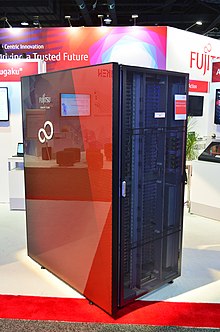Fugaku (supercomputer)
Fugaku (Japanese: 富岳) — named after an alternative name for Mount Fuji — is a petascale supercomputer at the RIKEN Center for Computational Science in Kobe, Japan. It started development in 2014 as the successor to the K computer, and it is scheduled to start operating in 2021,[4] although parts of the computer were put into operation in June 2020.[5] It is the fastest supercomputer in the world in the TOP500 list.[6]
| Active | From 2021 |
|---|---|
| Sponsors | MEXT |
| Operators | RIKEN |
| Location | RIKEN Center for Computational Science (R-CCS) |
| Architecture |
|
| Operating system | Custom Linux-based kernel |
| Memory | HBM2 32 GiB/node |
| Storage | |
| Speed | 415 PFLOPS (per TOP500 Rmax) |
| Cost | US$1 billion (total programme cost)[2][3] |
| Ranking | TOP500: 1, June 2020 |
| Web site | www |
| Sources | Fugaku System Configuration |

Hardware
The supercomputer is built with the Fujitsu A64FX microprocessor. This CPU is based on the ARM version 8.2A processor architecture, and adopts the Scalable Vector Extensions for supercomputers.[7] Fugaku was aimed to be about 100 times more powerful than the K computer (i.e. a performance target of 1 exaFLOPS) and have a high level of practicability in the world.[8][9] Fugaku uses 158,976 A64FX CPUs joined together using Fujitsu's proprietary torus fusion interconnect.[6]
The final reported performance of Fugaku is a Rpeak of 0.54 exaFLOPS in the FP64 used by the TOP500.[6]
Software
Fugaku will use a "light-weight multi-kernel operating system" named IHK/McKernel. The operating system uses both Linux and the McKernel light-weight kernel operating simultaneously and side-by-side. The infrastructure that both kernels run on is termed the Interface for Heterogeneous Kernels (IHK). The high-performance simulations are run on McKernel, with Linux available for all other POSIX-compatible services.[10][11][12]
History
On May 23, 2019, RIKEN announced that the supercomputer was to be named Fugaku.[13] In August 2019, the logo for Fugaku was unveiled; it depicts Mount Fuji, symbolising "Fugaku's high performance" and "the wide range of its users".[4][14] In November 2019, the prototype of Fugaku won first place in the Green500 list.[15][16] Shipment of the equipment racks to the RIKEN facility began on December 2, 2019,[17] and was completed on May 13, 2020.[18] In June 2020, Fugaku became the fastest supercomputer in the world in the TOP500 list, displacing the IBM Summit.[6]
Cost
In 2018 Nikkei reported the programme would cost ¥130 billion (c. US$1 billion ).[3] The cost of the programme has caused significant controversy: in June 2020 the New York Times reported criticism of the expense, and that similar near-future exascale supercomputers would cost less and overtake Fugaku's performance.[2]
Comparison
| Name | Start Year | End Year | Performance (PFLOPS)[note 1] |
Cost (Million USD) |
TOP500 Ranking | CPU/GPU Vendor | CPU | OS |
|---|---|---|---|---|---|---|---|---|
| Fugaku | 2020 | - | 415 | 1213[3][note 2] | June 2020 1st | Fujitsu | A64FX | Custom Linux-based kernel |
| Summit | 2018 | - | 148 | 300[19] | June 2018 to November 2019 1st | IBM, NVIDIA | POWER9, Tesla | Linux (RedHat) |
| Sierra | 2018 | - | 94 | November 2018 to November 2019 2nd | ||||
| Sunway TaihuLight | 2016 | - | 93 | 280[20] | June 2016 to November 2017 1st | NRCPC | Sunway SW26010 | Linux (Raise) |
| K | 2011 | 2019 | 10 | 1045[21] | June 2011 - November 2011 1st | Fujitsu | SPARC64 VIIIfx | Linux |
See also
- K computer
- ARM supercomputers
References
- "Post-K (Fugaku) Information". Fujitsu. Retrieved 2020-06-23.
- Clark, Don (22 June 2020). "Japanese Supercomputer Is Crowned World's Speediest". The New York Times. Retrieved 26 June 2020.
- Takei, Tomohisa (14 September 2018). "お値段1300億円のポスト「京」、IT業界は今度こそ生かせるか". 日経クロステック(xTECH) (in Japanese). Nikkei. Retrieved 28 June 2020.
- "スーパーコンピュータ「富岳」プロジェクト" (in Japanese). 理化学研究所. Retrieved 2019-05-25.
- "Supercomputer Fugaku, named after Mt. Fuji, makes its debut". The Asahi Shimbun. 2020-06-16. Retrieved 2020-06-23.
- Cutress, Dr Ian (22 June 2020). "New #1 Supercomputer: Fujitsu's Fugaku and A64FX take Arm to the Top with 415 PetaFLOPs". www.anandtech.com. Retrieved 22 June 2020.
- "ポスト「京」のCPUの仕様を公表" (in Japanese). 富士通. 2018-08-22. Retrieved 2019-05-25.
- "スパコン「京」後継機は「富岳」 計算性能100倍、21年稼働". 毎日新聞 (in Japanese). 2019-05-23. Retrieved 2019-05-30.
- "Fugaku Remakes Exascale Computing In Its Own Image". 2019-12-09. Retrieved 2020-06-22.
- "Outline of the Development of the Supercomputer Fugaku". RIKEN Center for Computational Science. Retrieved 2020-06-23.
- "McKernel". RIKEN. Retrieved 2020-06-23.
- mckernel on GitHub
- "ポスト「京」の名称 「富岳(ふがく)」に決定" (in Japanese). 理化学研究所. 2019-05-23. Retrieved 2019-05-25.
- "R-CCS announced the Fugaku logo | RIKEN Center for Computational Science RIKEN Website". www.r-ccs.riken.jp. RIKEN Center for Computational Science. Retrieved 23 June 2020.
- "November 2019". TOP500.org. Retrieved 2019-11-20.
- "Fugaku prototype named greenest supercomputer". RIKEN. 2019-11-18. Retrieved 2019-11-20.
- "Fujitsu Begins Shipping Supercomputer Fugaku". Fujitsu. 2019-12-02. Retrieved 2020-06-23.
- "Delivery of the Supercomputer Fugaku has been Completed". RIKEN Center for Computational Science. 2020-05-13. Retrieved 2020-06-23.
- 3億2500万ドルスパコン「TOP500」、IBM製「Summit」で米が中国を抜き首位に返り咲き
- 開発費 約18億元 頂上極めた「富岳」の次の挑戦、日本が強い分野の開発に生かせるか
- 「2位じゃダメ」のスパコン京、見納め 6年超す長寿で
External links
- Official website

- Official website (in Japanese)
| Records | ||
|---|---|---|
| Preceded by IBM Summit |
World's most powerful supercomputer June 2020 - |
Incumbent |